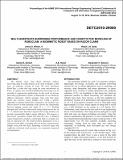Multi-Substrate Burrowing Performance and Constitutive Modeling of RoboClam: A Biomimetic Robot Based on Razor Clams
Author(s)
Winter, Amos G.; Deits, Robin Lloyd Henderson; Dorsch, Daniel S.; Slocum Jr., Alexander H; Hosoi, Anette E.
DownloadMulti-substrate burrowing.pdf (733.9Kb)
PUBLISHER_POLICY
Publisher Policy
Article is made available in accordance with the publisher's policy and may be subject to US copyright law. Please refer to the publisher's site for terms of use.
Terms of use
Metadata
Show full item recordAbstract
The Atlantic razor clam (Ensis directus) reduces burrowing drag by using motions of its shell to fluidize a thin layer of substrate around its body. We have developed RoboClam, a robot that digs using the same mechanisms as Ensis, to explore how localized fluidization burrowing can be extended to engineering applications. In this work we present burrowing performance results of RoboClam in two distinctly different substrates: ideally granular 1mm soda lime glass beads and cohesive ocean mudflat soil. Using a genetic algorithm to optimize RoboClam’s kinematics, the machine was able to burrow in both substrates with a power law relationship between digging energy and depth of n = 1.17. Pushing through static soil has a theoretical energy-depth power law of n = 2, which means that Ensis-inspired burrowing motions can provide exponentially higher energy efficiency. We propose a theoretical constitutive model that describes how a fluidized region should form around a contracting body in virtually any type of saturated soil. The model predicts fluidization to be a relatively local effect, extending only two to three characteristic lengths away from the body, depending on friction angle and coefficient of lateral earth pressure, two commonly measured soil parameters.
Date issued
2010-08Department
Massachusetts Institute of Technology. Precision Engineering Research Group; Massachusetts Institute of Technology. Department of Physics; Hatsopoulos Microfluids Laboratory (Massachusetts Institute of Technology)Journal
Volume 2: 34th Annual Mechanisms and Robotics Conference, Parts A and B
Publisher
ASME International
Citation
Winter, Amos G., Robin L. H. Deits, Daniel S. Dorsch, A. E. Hosoi, and Alexander H. Slocum. “Multi-Substrate Burrowing Performance and Constitutive Modeling of RoboClam: A Biomimetic Robot Based on Razor Clams.” Volume 2: 34th Annual Mechanisms and Robotics Conference, Parts A and B (2010). © 2010 ASME International
Version: Final published version
ISBN
978-0-7918-4410-6